Abstract
The water-retaining and yield-increasing capacity of super-absorbent polymer (SAP) are essential for soil remediation in arid and semi-arid areas. Water availability is an increasing challenge to plant development and crop yield. During the growing seasons in 2021 and 2022, the present study was conducted to evaluate the effect of the addition of different amounts of SAP on the development and yield of green beans (Phaseolus vulgaris L. cv Bronco) under varying water deficit stresses, compared with the control treatment without SAP and water deficit stress. The results demonstrated that a 50% reduction in water requirement (WR) resulted in significant decreases in leaf fresh weight, specific leaf area, leaf total chlorophyll content, pod number, leaf free water content, pod fresh weight per plant, and yield. Decreases were also found in pod total chlorophyll content, carotenoids, dry matter and total protein, leaf proline content, and crude fiber content. Additionally, leaf water saturation deficit was significantly increased under the stress compared with the full irrigation at 100% WR. However, irrigation at 75% WR increased pod contents of ascorbic acid, total sugars, and leaf bound water. The current study also indicated that addition of SAP significantly enhanced the above-mentioned growth characteristics under irrigation at 50% and 75% WR. Treatment with SAP at 3 g/plant was the most effective in mitigating the adverse effects of water deficiency, especially at the irrigation rate of 75% WR. Pearson’s correlation analysis showed significantly positive correlations between the growth parameters, as well as pod yield, under water stress and SAP. This study provides a promising strategy for green bean cultivation by adding SAP to soil to alleviate water shortage stress.
1. Introduction
Green bean (Phaseolus vulgaris L.) is an annual plant belonging to the Leguminosae family and requires a warm growth season. In Egypt, it is planted for exportation or local consumption. It is considered to be a perfect source of protein, fiber, and carbohydrate, in addition to vitamins C and A [1,2,3], and benefits the diet because bean protein is rich in lysine. Eating green beans is beneficial for human health as they provide protein and some important nutrients. Their cultivation is also beneficial for soil fertility as green bean is a non-stressful crop for the soil and, because it is a leguminous crop, it fixes atmospheric nitrogen. Therefore, it is recognized as an important plant in Egypt. A good total yield of green bean is considered to be the main objective of planting and for the producer to receive high returns. It can be grown in three lugs mainly in summer, Nile and winter, and the possibility exists of growing green bean in new reclaimed lands and under greenhouses or tunnels. In Egypt, in 2022, the cultivated area of this crop was 23,184 ha, with production of about 24,313 tons and productivity of 10.524 tons per hectare. Green beans ranked third in vegetable exports after potatoes and onions, with an average export volume of around 20,440 tons and a value of USD 22.70 million. The three largest foreign export markets for Egyptian green beans are Italy, the United Kingdom, and the Netherlands [4].
Managing irrigation involves giving plants the right amount of water, i.e., neither too much nor too little, around their root zones. This is a crucial issue and a major factor for horizontal expansion in the agricultural sector, particularly in arid and semi-arid regions, because of many factors, such as water scarcity and changing climate conditions. Climatic changes may cause a greater evapotranspiration rate via the increasing temperature, which has led to reduced and irregular rainfall [5,6]. The strategic program in Egypt involves the extension of desert reclamation in the coming years [7]. In Egypt, new reclaimed lands are located in water-scarce regions, which are characterized as arid lands, and, at the same time, vegetable crop farming is expanding [8,9,10]. Moreover, drought is the greatest environmental stress that adversely affects plant growth and development, limiting crop production [11,12]. Green bean is sensitive to water stress at all developmental stages, particularly flowering and pod formation [13,14]. Studies of bean plants revealed that water stress treatments had a substantial impact on vegetative development and pod yield [15,16,17]. Over time, there has been greater use of soil amendments like SAP, which is well known for its capacity to hold water and enhance the physical characteristics of the soil, particularly in regions with a lack of water, like the majority of the Middle East and Africa [18,19].
SAP is a flexible polymer that has loosely cross-linked with a few widthwise linkages. This allows it to absorb and store water weighing hundreds of times more than the polymer’s dry weight [19,20]. The performance of SAP is controlled by its chemical properties, including its structure, molecular weight, and hydrogel formation conditions. In field applications, SAP reduces soil hydraulic conductivity due to its water-holding capacity [21]. Some studies determined that swollen SAP reduced the largest pores in the soil [22]. Additionally, the mixing ratio of soil and SAP, and the impact of the swellability of SAP, expanded the interaction between soil and SAP to a greater extent. Application of SAP and its addition to the soil increased the saturated and residual water content, increased the water-holding capacity and available water content [21], and reduced leakage and subsequent losses due to deep filtration [19].
The advantage of SAP for agricultural use is that it has been widely used as a promising material in agricultural sectors because its use leads to the regulated release of water and agricultural chemicals. This results in water conservation, reducing the quantities used, and reducing agricultural chemicals, thus reducing both environmental problems and toxicity. Toxic agents can be chemically bound to mammals as carriers. The use of SAP and the controlled release of bioactive substances in the agricultural sector also provides advantages over conventional formulations [23].
Treatment with SAP increases water use efficiency and plant productivity while increasing plant biomass [19,24]. The same results have been observed as a result of SAP application to soil in soybean [25] and other plants such as tomato, lettuce, wheat, barley, chickpea, and some tree species [26]. The success rate of SAP amendment in soils of semi-arid and arid regions can be attributed to the release of water when the temperature surrounding the swollen SAP increases, resulting in increased survival [19,21]. SAP can be used in farming to improve the physical features of soil and increase its capacity to hold water [18,19], reduce water waste and minimize the leaching of nutrients from soil [27], and reduce water evaporation from soil [19], leading to better growth for plants, and thus increasing crop and vegetable productivity under normal irrigation conditions and drought stress. Therefore, SAP may provide an excellent solution for plants growing on newly reclaimed land in sandy soils and for plants that may suffer even partially from drought stress [8,28,29,30]. In this regard, the use of SAP has been shown to mitigate the hazardous effects of drought in some legumes such as red beans [31,32,33], mung beans [34], and snap beans [35]. In addition, the use of SAP has been reported to mitigate the harmful effects of drought in some vegetable crops [8], such as tomato [36,37,38,39], lettuce [40], squash [41], and pumpkin [42]. The above research indicates the additional importance of this study, and the importance of applying it in new reclaimed areas, while providing the fertilizers and quantities of irrigation water used in agriculture. Therefore, this study was conducted to evaluate the effects of using super-absorbent polymer (SAP) on the growth and productivity of green bean plants (Phaseolus vulgaris L.) under different irrigation conditions. We hypothesized that this substrate could influence the yield structure, quality, and quantity of green beans.
2. Materials and Methods
2.1. Field Site and Treatments
The existing study was conducted in an open field at Al-Sadat Experimental Farm of the Faculty of Agriculture, Al-Azhar University, Monofia Governorate, Egypt, during the 2021 and 2022 seasons. The aim was to assess the effects of adding SAP to overcome water deficit stress on the development and yield of green bean (Phaseolus vulgaris L.) cv. Bronco. The SAP used was a mixture of cationic SAP (polyacrylamide allylamine hydrochloride gel 20% cationicity) and anionic SAP (polyacrylamide K polyacrylate gel 30% anionicity). The hydrogel polymers were obtained from Lucky Star TG, Egypt, produced by a Russian company called “Aqua Gool, AG, Russian. Before sowing, three quantities of SAP, 1, 2, and 3 g per hill, were added and stirred to mix completely with the soil at the location of each hill in the top 25 cm of soil. On 3 September, the seeds were planted directly in the field, with a 10 cm distance between each row of plants. Each row was 3.5 m long and 60 cm wide. Plants were thinned to one plant per hill after full germination. After the treatments, the plants were irrigated, with water deficit stress levels at 50% and 75% of water requirement, as well as a control treatment without adding SAP, which was irrigated with 100% of irrigation water. The following equation was used to determine the irrigation amounts:
where Etc is the crop evapotranspiration in mm/day. The Penman–Monteith equation was used to compute the reference evapotranspiration (Eto), mm/day, while the crop coefficient (Kc) was adjusted based on the crop’s features and developmental stage according to Allen et al. [43]. The total quantity of WR (m3/h) is shown in Table 1. The irrigation operation was undertaken every two days during the experiment period from cultivation to harvesting, using a T-Tape drip irrigation line placed on the center of the raised row; this was employed with 15 cm emitter spacing and a flow rate of 10 L m−1 h−1 at an operating pressure of 0.55 bar.
Etc = Eto × Kc,

Table 1.
Seasonal irrigation quantities under different rates of water requirement for the Bronco cultivar under experimental conditions during 2021 and 2022 seasons.
2.2. Experimental Design
As stated above, the experiment was conducted to study the effects of nine treatments among three levels of SAP to overcome water deficit stress rates, including 50% and 75% of water requirement (WR), as well as a control treatment without adding SAP. Randomized complete blocks with three replicates were used, and the nine treatments are listed in Table 2. The physical and chemical properties of the soil experiment site are presented in Table 3. The Egyptian Ministry of Agriculture recommendations regarding cultural procedures, such as fertilization and disease and pest control, were practiced.

Table 2.
Treatments of different irrigation rates and applications of super-absorbent polymer.

Table 3.
Physical and chemical properties of the experimental soil.
2.3. Studied Traits
2.3.1. Leaf Parameters
At 65 days from sowing, ten green bean plants were randomly selected from each treatment in order to quantify leaf fresh weight (FW) and specific leaf area (SLA), according to Patane et al. [44], as physical parameters:
where LA: leaf area (cm2) and DW: leaf dry weight (g).
Specific leaf area (cm2 g−1) = LA/DW
Leaf Chemical Properties
Leaf dry matter percentage was determined per 100 g after drying at 70 °C until a constant weight was attained. Total chlorophyll content (mg/g FW) was determined in leaves according to the method described by Lichtenther [45] using spectrophotometry (6800 UV/Vis Spectrophotometer, Jenway, Bibby Scientific Ltd., Staffordshire, UK). In addition, the proline content (mg/g FW) was calculated using the colorimetric method at wavelengths of 520 nm according to Bates et al. [46].
2.3.2. Pod Parameters
After reaching the marketable stage, pod samples were collected randomly from five plants from each replicate to determine the physical features, such as pod number and fresh weight per plant (g).
Pod chemical components:
Total chlorophyll and carotenoid contents (mg/g FW) were determined using the Lichtenther method [45]; ascorbic acid was determined in mg/100 g FW using titration with 2, 6-dichlorophenol indophenol dye (DCPIP) according to the method of Rao and Deshpande [47]. Total sugars were assessed using the method of Smith et al. [48]; total soluble solids (TSS), total protein, and dry matter contents using the method described in the Association of Official Analytical Chemists (A.O.A.C.) 2005 [49]; and crude fibers using the method of Sadasivam and Manickam [50].
2.3.3. Yield and Relative Yield Increases
From the start of the harvesting stage to the end of the growing season, the green pods were picked, the weight of the total yield was recorded, and the relative yield increase was determined according to Alomari-Mheidat et al. [51].
2.3.4. Water Status
Water status, including the water saturation deficit (WSD), was determined according to Quilambo [52] as follows:
where RWC is the relative water content. The leaf free and bound water contents were determined according to Chmeleva and Kucher [53].
WSD = 100 − RWC,
2.4. Statistical Analysis
According to the procedure outlined by Snedecor and Cochran [54], data of the two studied seasons were arranged and a homogeneity test was performed. Data were statistically analyzed using CoStat software (version 6, CoHort Software, Monterey, CA, USA). For significant differences between the treatments at p < 0.05, analysis of variance (ANOVA) and Duncan’s multiple range test were used [55]. The Pearson test was used to calculate correlations at p < 0.05 and 0.01 using OriginPro 2023 (OriginLab Corporation, Northampton, MA, USA) [56].
3. Results
3.1. Plant Parameters
The results of this study showed that decreasing irrigation amounts up to 50% WR decreased leaf fresh weight and specific leaf area (SLA) (Figure 1). However, non-significant increases were recorded between 75% WR and 100% WR as the control. Additionally, results showed that applying SAP to water deficit stress treatments had a positive and significant effect on most growth parameters. It was found that the maximum values of specific leaf area were produced by applying 3 and 1 g SAP/plant in the presence of 50% and 75% WR in both seasons, respectively (Figure 1). In addition, applying 3 g/plant of SAP under 75% WR recorded the highest significant trend in leaf fresh weight. However, under the conditions of 50% WR with the addition of SAP at 1 g/plant, the results recorded the lowest significant values of vegetative growth.
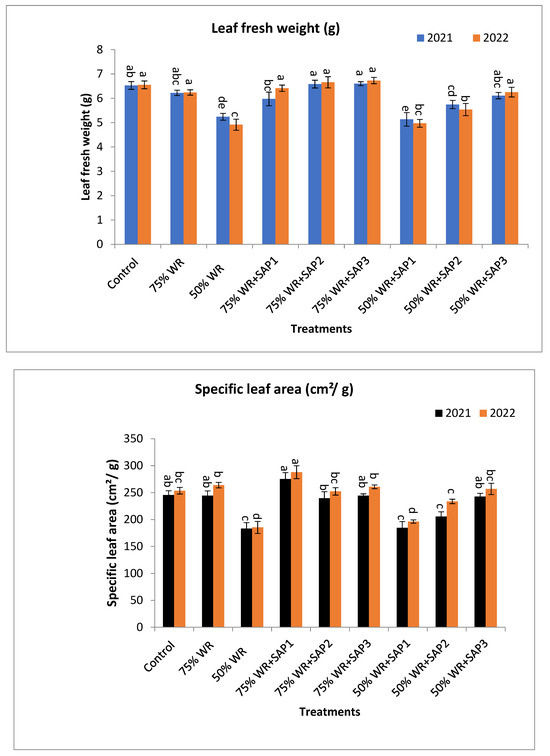
Figure 1.
Effect of the combinations of rates of water requirement (WR) and amounts of super-absorbent polymer (SAP) on fresh leaf weight and specific leaf area in green bean plants during 2021 and 2022 seasons. Different letters indicate significant differences between values at p ≤ 0.05 according to Duncan’s multiple range test. Bar represents the standard deviation.
With respect to leaf dry matter and total chlorophyll, the data showed that these contents were significantly decreased at a water shortage of 50% WR compared with the control at 100% WR (Figure 2). Interference between WR rates and SAP amounts indicated that the increase in SAP amounts up to 3 g/plant under water shortage rates led to an increase in total dry matter and chlorophyll contents. Therefore, the highest content of leaf dry matter and total chlorophyll was obtained by adding 3 g/plant SAP in the presence of 75% WR, while the lowest significant result was obtained using 1 g/plant SAP and the irrigation rate at 50% WR (Figure 2).

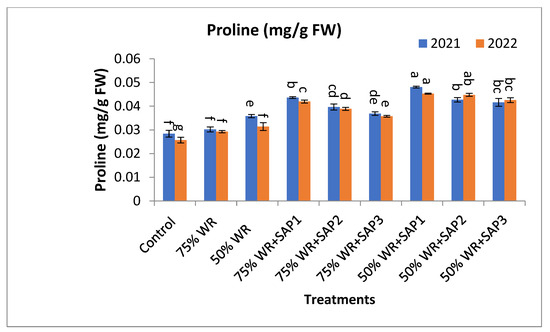
Figure 2.
Effect of the combinations of rates of water requirement (WR) and amounts of super-absorbent polymer (SAP) on leaf dry matter (g), and total chlorophyll and proline contents (mg/g fresh weight) in green bean plants during 2021 and 2022 seasons. Different letters indicate significant differences between values at p ≤ 0.05 according to Duncan’s multiple range test. Bar represents the standard deviation.
The results showed that the plants that were treated with 50% WR had a much greater leaf proline content than those treated with irrigation at a rate of 75% WR and the control (100% WR). The results showed that adding SAP under the same amount of irrigation water led to a reduction in proline content. The lowest value for proline was under the addition of 3 g (75% WR + SAP3), followed by 75% WR + SAP2, then 75% WR + SAP1. The results showed the same trend under the use of 50% WR. This shows that adding the SAP at a rate of 3 g/plant reduces proline accumulation in plant leaves using an amount of 75% WR.
3.2. Pod Parameters
Data in Figure 3 show that there were significant decreases in pod number per plant and pod fresh weight per plant with decreasing amounts of irrigation water from 75% WR to 50% WR, compared with the rate of 100% WR as the control. By comparison, the addition of SAP from 1 to 3 g/plant under 50% and 75% WR led to an increase in the pod number per plant and pod fresh weight per plant. In more detail, the treatment of 3 g/plant SAP under 75% WR produced the highest values of these characters, whereas the lowest was from the treatment of 1 g/plant of SAP under 50% WR (Figure 3).
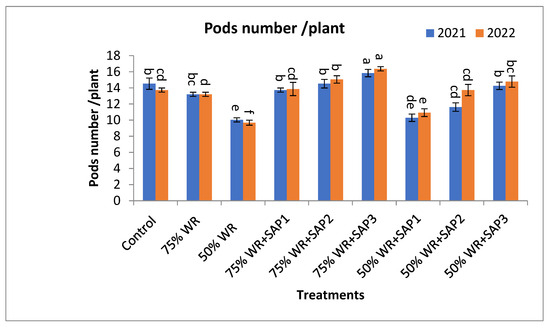

Figure 3.
Effect of the combinations of rates of water requirement (WR) and amounts of super-absorbent polymer (SAP) on pod number and pod fresh weight per plant (g/Plant) in green bean plants during 2021 and 2022 seasons. Different letters indicate significant differences between values at p ≤ 0.05 according to Duncan’s multiple range test. Bar represents the standard deviation.
The data concerning pod total chlorophyll and carotenoid contents indicated that these contents were significantly decreased by water shortages of 75% and 50% WR compared with the control at 100% WR (Figure 4). By comparison, interference between WR rates and SAP amounts showed that the largest contents of chlorophyll a, b, and total chlorophyll of pods were found by adding 3 g/plant of SAP in the presence of 75% WR, while the least significant result was observed from using SAP at 1 g/plant and the irrigation rate of 50% WR (Figure 4).
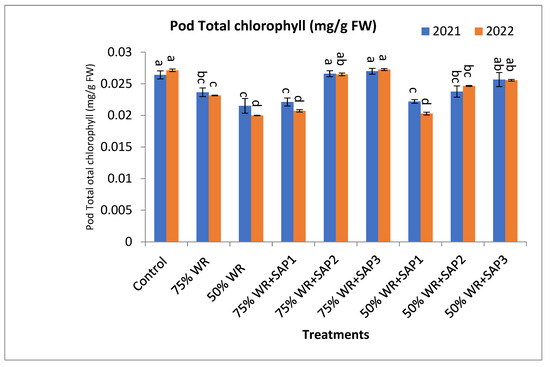
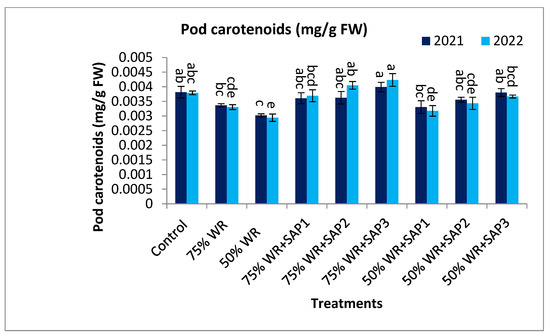
Figure 4.
Effect of the combinations of rates of water requirement (WR) and amounts of super-absorbent polymer (SAP) on pod total chlorophyll (mg/g fresh weight) and carotenoid contents (mg/g fresh weight) in green bean plants during 2021 and 2022 seasons. Different letters indicate significant differences between values at p ≤ 0.05 according to Duncan’s multiple range test. Bar represents the standard deviation.
Regarding pod ascorbic acid and total sugar contents, the results reflect that there were significant increases in these traits from using the shortage of water at 75% WR compared with 100% WR as the control (Figure 5). Evidence from our results indicated that the best results in these contents in pods were achieved from using 1 g/plant SAP under 75% WR, and the worst results were from adding 1 g/plant SAP under 50% WR and the control.
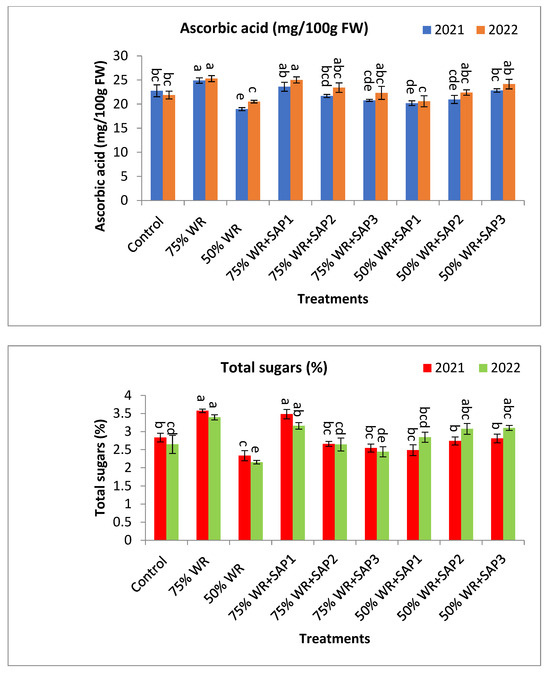
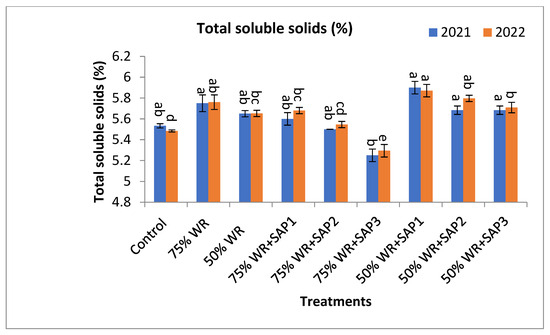
Figure 5.
Effect of the combinations of rates of water requirement (WR) and amounts of super-absorbent polymer (SAP) on ascorbic acid (mg/100 g fresh weight), and total contents of sugars and total soluble solids in green bean plants during 2021 and 2022 seasons. Different letters indicate significant differences between values at p ≤ 0.05 according to Duncan’s multiple range test. Bar represents the standard deviation.
The results in Figure 5 show that by increasing water shortage up to 50% WR, TSS of green been pods did not show significant differences between 75% and 50% WR, despite the best results coming from the shortage rate of 75% WR. The results showed that applying SAP at 1 g/plant to the lower water irrigation treatment of 50% WR yielded the maximum value of TSS content, while applying 3 g/plant SAP in the presence of 75% WR produced the minimum value of this content (Figure 5).
The data also revealed that the highest values of dry matter content of green bean pods were observed under the control of 100% WR, followed by 75% WR, and the lowest value was observed at 50% WR. However, applying 1, 2, and 3 g of SAP per plant in soil under a water condition of 75% WR resulted in a non-significant increase in dry matter content when compared to other treatments; Figure 5.
In terms of pod protein content, Figure 6 shows that there was no statistically significant difference between irrigation rates at 75% WR and 100% WR as a control, and a significant decrease happened with 50% WR. The obtained results also showed that using the treatment of 2 g/plant SAP and irrigation with the rate of 75% WR resulted in the highest value, while using treatments of 1 and 2 g/plant SAP and irrigation with the rate of 50% WR resulted in the lowest content values in the first and second growing seasons, respectively.

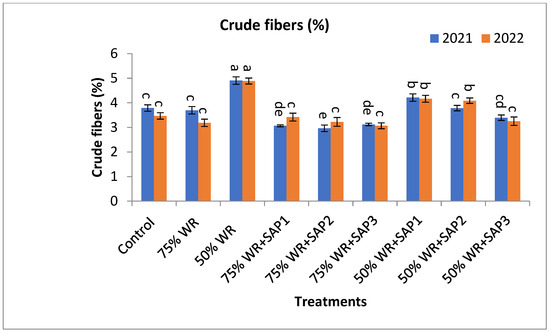
Figure 6.
Effect of the combinations of rates of water requirement (WR) and amounts of super-absorbent polymer (SAP) on pod dry matter proteins and crude fibers in green bean plants during 2021 and 2022 seasons. Different letters indicate significant differences between values at p ≤ 0.05 according to Duncan’s multiple range test. Bar represents the standard deviation.
The data obtained showed that crude fiber content of pod increased significantly with a decrease on the rates of irrigation up to 50% WR compared with 100% WR as a control. Hence, adding 1 g/plant SAP to soil with the water shortage condition of 50% WR yielded the highest significant value of this content, whereas the lowest happened with the treatments of 2 and 3 g/plant and irrigation at the rate at 75% WR (Figure 6).
3.3. Yield and Relative Yield Increase
Regarding pod yield, the results in Figure 7 show that irrigation with 75% WR and 50% WR resulted in a significant reduction in yield compared with the control. The addition of SAP led to a significant increase in yield under water shortage conditions of 75% WR and 50% WR. An increase in relative yield was found with increasing the quantities of SAP. The results also showed that applying SAP amounts of 2 and 3 g/plant at 75% WR gave the highest values.
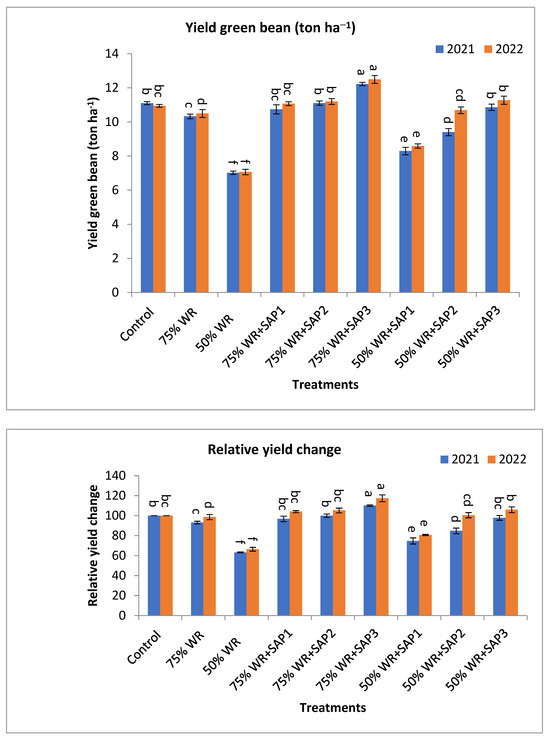
Figure 7.
Effect of the combinations of rates of water requirements (WR) and amounts of super-absorbent polymer (SAP) on yield green bean and the relative yield change in green bean plants during 2021 and 2022 seasons. Different letters indicate significant differences between values at p ≤ 0.05 according to Duncan’s multiple range test. Bar represents the standard deviation.
The results in Figure 7 show that lower irrigation water rates led to a decrease in the relative increase in green bean pod yield from 98.6% to 93% under the irrigation rate of 75% WR, and decreased from 66.4% to 63% under the irrigation rate of 50% WR, compared to the control irrigation rate of 100% WR in the first and second seasons, respectively. Adding SAP from 1 to 3 g/plant under 50% WR and 75% WR also increased the yield. In addition, treatment with 3 g/plant of SAP under 75% WR resulted in obtaining the highest values of relative yield increase, which were 117.4% and 110.1% in the two seasons, respectively.
3.4. Water Statues
The data in Figure 8 indicate that water saturation deficit increased significantly under the water shortage of 50% WR compared with 100% WR as a control. By comparison, adding SAP under the irrigation rates of 50% and 75% led to significantly decreased water saturation deficit compared with the untreated plants. The highest value of water saturation deficit resulted under 75% WR, while the lowest value was found in the control in first season, and the treatment applying 3 g SAP under 75% WR.
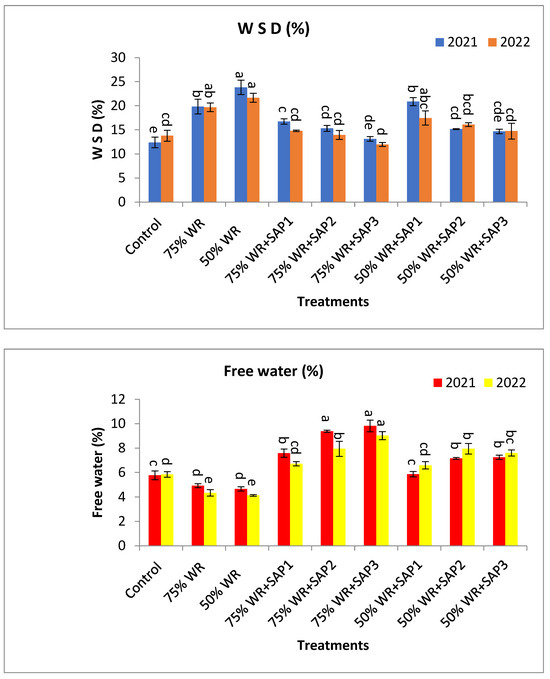
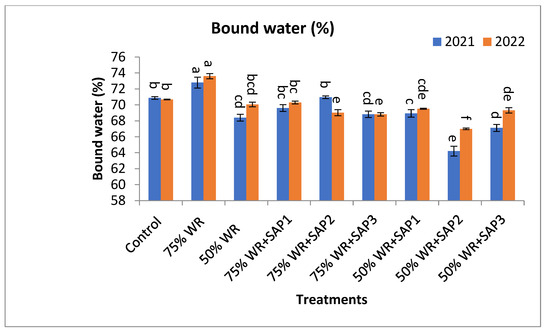
Figure 8.
Effect of the combinations of rates of water requirements (WR) and amounts of super-absorbent polymer (SAP) on water saturation deficit (WSD), and free and bound water in green bean plants during 2021 (A) and 2022 (B) seasons. Different letters indicate significant differences between values at p ≤ 0.05 according to Duncan’s multiple range test. Bar represents the standard deviation.
The results show that the lowest value of free water content was observed under irrigation rates of 75% WR and 50% WR. SAP applications significantly affected free water under water deficit conditions of 75% WR and 50% WR, as there was an increase in free water content with an increasing amount of SAP. Adding an amount of SAP at rates of 2 and 3 g/plant at 75% WR resulted in obtaining the highest values of free water, while the lowest values resulted under irrigation rates of 75% and 50% WR without adding SAP; Figure 8.
The bound water content was not significantly affected by the different treatments in the first season. However, data in the second season showed that the bound water content increased significantly under a water deficit at the irrigation rate of 75% WR compared to the irrigation rate of 100% WR as a control. By comparison, adding SAP under water deficit treatments led to a decrease in bound water content compared to 75% WR and 50% WR in the absence of SAP, especially in the second season. Hence, a significant decrease was observed in the 2 g SAP/plant treatment at 50% WR, while the highest significant values for water associated with water deficit appeared at 75% WR; Figure 8.
3.5. Pearson’s Correlation Analysis
The Pearson’s correlation analysis showed significant correlations (positive or negative) between different attributes of green bean under the treatments of water stress and SAP (Figure 9). Analysis was conducted on the average data from the two studied seasons. A positive association of the measured parameters is shown with a red circle, and a negative correlation with a blue circle, in Figure 9. A positive correlation (p < 0.05 and 0.01) was observed between yield (ton/ha) with growth parameters i.e., leaf fresh weight, specific leaf area, leaf total chlorophyll, and pod number per plant. Moreover, the green bean yield was positively correlated with quality parameters, including pod total chlorophyll, pod carotenoids, pod dry matter, and total proteins. A positive correlation existed between total proteins and leaf fresh weight and pod dry matter (p < 0.01); a positive correlation (p < 0.05) was also obtained between specific leaf area and pod number per plant, pod fresh weight, and pod carotenoids. On the other hand, crude fiber content in green bean was correlated negatively with yield, pod dry matter, total proteins (p < 0.01), leaf total chlorophyll, ascorbic acid, and total sugars (p < 0.05).
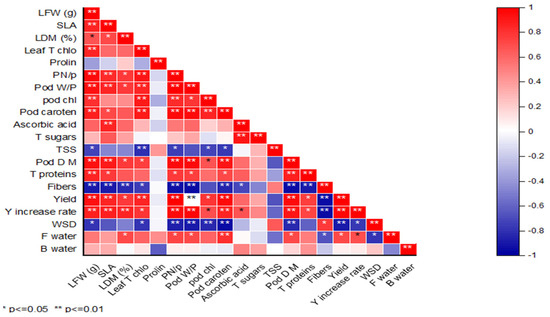
Figure 9.
Pearson’s analysis of correlations (*, ** p ≤ 0.05 and 0.01) between the parameters of green bean plants, such as leaf fresh weight (LFW), specific leaf area (SLA), leaf dry matter (LDM), total chlorophyll (Tchl), proline contents, pod number (PN), pod weight (PW), pod chlorophyll (Pchl), carotene (p car), ascorbic acid (ASA), total sugars (T sugars), total soluble solids (TSS), pod dry matter (PDM), proteins, crude fiber, yield, relative increase in yield, water saturation deficit (WSD), free water (F water), and bound water (B water).
4. Discussion
Water shortages are a growing problem in many parts of the world, including Egypt, due to the lack of water resources and climatic variations [57]. One strategy to overcome water scarcity is to modify the soil with different amendments, especially in sandy soil conditions [58]. The application of SAP to green bean plants under a water deficit have positive effects on plant growth, productivity, and pod quality parameters. The results showed that decreasing the irrigation rate to 50% WR led to significant decreases in specific leaf area, leaf fresh weight, pod number, pod fresh weight per plant, and yield. These findings may indicate that irrigation with 50% WR led to increased moisture tension in the surrounding root zone, resulting in inadequate soil moisture and nutrients during the plants’ growth periods. Hence, green bean yield is most significantly impacted by water stress during the vegetative growth stage and before pod establishment. These declines could be linked to the water deficit stress because stomatal closure reduced CO2 uptake and, consequently, photosynthesis [59,60]. This decline in photosynthesis slowed plant development, and decreased production of dry matter, assimilation, and dry matter partitioning [12,61,62]. Therefore, the reductions in pods yield under water deficiency (Figure 3) are in agreement with the decreases in total chlorophyll content (Figure 2) and plant growth characteristics (Figure 1). Another point of view suggests that the declines in growth characteristics may be related to the detrimental impacts of water deficit stress on cell division, cell enlargement, and cell differentiation processes, which adversely affect plant growth, pod features, and quality [63,64].
On the other hand, our results indicated that SAP applications had positive effects on the tested characteristics of water-stressed green bean plants at 50% WR and 75% WR. In addition, applying 3 g/plant of SAP under 75% WR resulted in the highest values of leaf fresh weight, pod number, and pod fresh weight per plant. These improvements in growth characteristics following the application SAP may be due to a rise in the moisture content in the soil around the activity root zone, via an improvement in the soil structure conditions and soil water-holding capacity [28,29,65]. This may have resulted in an increase in the period required to reach the permanent wilting point [66,67], which led to an increase in the available moisture amount in the root zone, thereby removing the stress and allowing the plants to continue growing in a favorable environment [28,68]. SAP has the potential to provide a controlled release of carrier fertilizer and act as a water-conserving agent [69]. In the current study, adding SAP somewhat mitigated the reduced green bean development in plants grown in water-stressed conditions.
The increase in green bean pod yield following the addition of 3 g SAP is attributable to its positive effects on the physical growth parameters (Figure 1), chlorophyll content (Figure 2), and physical characteristics of the pods (Figure 3), which was brought on by an improvement in the soil’s ability to hold water and retain nutrients. Yield showed positive relationships, having the highest correlation rates with pod weight, pod number, pod dry matter content, total carotenoid content, leaf fresh weight, leaf dry matter, specific leaf area, and leaf total chlorophyll; Figure 9. This is due to the fact that most of these characteristics directly affect the quantity of the yield, as they are either some of the yield’s components, or they are among the characteristics that affect the growth of the plant and its vital processes, such as photosynthesis.
The changes happening in the chemical components indicated that leaf total chlorophyll, pod total chlorophyll, pod total carotenoids, dry matter, and total protein contents were decreased as the amount of water decreased from 75% to 50% WR. The decreases in chlorophyll content under water deficit stress are considered to be a typical indicator of oxidative stress and may be caused by chlorophyll breakdown and pigment photo-oxidation [70,71,72]. The decrease in chlorophyll content is paralleled by declines in plant growth indicators (Figure 1). As a result, a plant’s ability to absorb sunlight and photosynthesis is compromised, which lowers dry matter content and total protein [73]. However, the combination of irrigation water rates and SAP amounts showed that the addition of 3 g/plant of SAP under 75% WR led to increases in leaf total chlorophyll, pod total chlorophyll, total carotenoid, dry matter, and total protein contents. The results suggested that using SAP under water stress conditions to maintain photosynthetic pigment content has a good impact. One of the most crucial uses of SAP in agriculture is to gradually add water to the plant, which has a favorable effect by reducing water stress, thereby increasing plant growth under stress [74,75]. Utilizing SAP has a beneficial impact on the chlorophyll content. The following mechanisms are provided as explanations: first, the roots absorbed water stored by the polymer when there was a water shortage; second, adding SAP considerably affects plant development and biomass accumulation by increasing the rate of CO2 absorption and the effectiveness of water utilization in plants grown in a water-stressed environment [76,77].
The results of the current investigation demonstrated that plants subjected to irrigation water rates of 50% WR had leaf proline contents that were significantly greater than those of the irrigation treatments at 75% WR and the control. Under drought conditions, the accumulation may be caused by increased proline biosynthesis enzyme activity or decreased proline degradation enzyme activity [78,79]. Here, the scientific evidence shows that proline accumulation is one of the crucial factors in maintaining the osmotic balance of the cell cytoplasm and preventing oxidative damage to the plant [78,80,81,82]. The findings also demonstrated that applying SAP at a rate of 3 g/plant reduced proline buildup in plant leaves at 75% WR. It was shown that SAP might be able to shield green bean plants from the effects of water stress and prevent them from suffering serious consequences [83]. These results indicated that application of SAP mitigates stress and creates suitable conditions for plant growth.
The findings of the pod chemical parameter investigations indicated that the irrigation rate at 50% WR produced the best results in terms of the levels of TSS, ascorbic acid, and total sugars (Figure 5). This can be attributed to water shortages causing the plant to regulate some metabolic activity by breaking down polysaccharides into simple sugars. This increases the amount of TSS and the rate at which organic acids (such as malic, citric, and ascorbic acids) are transformed, which is crucial for osmotic adjustment in plants [84].
It is noteworthy that the highest value in TSS content was observed with the SAP application at 1 g/plant with the low water irrigation treatment of 50% WR. This was attributed to enhanced metabolic activities, which resulted in the synthesis of large amounts of acids, metabolites, and glucose. These created reserves helped the original formation of TSS.
From the results of the current investigation, it was observed that applying 1 g/plant SAP under 75% WR resulted in increasing the ascorbic acid and total sugar contents in the pod, and these increases may be attributed to a reduction in the ascorbic acid oxidase enzyme in the plants as a result of the application of SAP, which provides the plant with sufficient amounts of water and nutrients under water deficit conditions [83].
With regard to pod crude fiber content, the results showed that it increased with decreasing rates of irrigation. SAP application at 2 and 3 g/ plant in soil at 75% WR gave the lowest significant value of pod crude fiber content. This is due to the features of water and nutrient retention of SAP, which generate favorable circumstances for improving crude fiber content under water deficiency [74,75,76].
Determination of water fractions or, as they are also called, water forms, was carried out via the refractometric method, under the action of a hypertonic 30–40% sucrose solution according to the principle proposed by Chmeleva and Kucher [53]. Determinations were carried out at 20 °C. Using this method, the free water content was found, and the bound water content was determined as the difference between total and free water. Regarding the water relations, the result indicated that water-stressed green bean plants at 75% WR and 50% WR had a lower free water content and higher bound water than the non-stressed plants of the control. These findings may be primarily attributable to an elevation in cell sap content and osmotic pressure as a result of the breakdown of polysaccharides into monosaccharaides [85,86]. SAP applications significantly affected leaf free and bound water contents under the water shortage conditions of 75% WR and 50% WR when the increase in free water and the decrease in content occurred with the addition of SAP. The water retention abilities of SAP may be responsible for these important consequences. The improved plant growth in plants treated with SAP may be related to the improvement in the water status of green bean plants. In this regard, the rise in free water and the decline in the content of bound water (Figure 7) correlated with the rise in the plant growth parameters of the plants cultivated in soils amended with SAP (Figure 1). Additionally, our findings demonstrated that the water saturation deficit under a water deficit at 50% WR increased dramatically in comparison to that at 100% WR as a control. This effect may be the result of diminished water and nutrient uptake and translocation caused by a water shortage. Therefore, the water saturation deficit is a crucial characteristic to consider when assessing the water status of plants [8].
5. Conclusions
The results of the present study showed that the addition of SAP resulted in significant improvements in various characteristics under water deficit conditions of 50% and 75% of the water requirement (WR). In general, it was found that the application of SAP at 3 g/plant mitigated the negative effects of water stress on the development and production of green bean plants. The beneficial effect of super-absorbent polymer under water stress was correlated with high leaf chlorophyll content, the enhancement in plant water status, and the decrease in leaf proline content. In turn, this improved plant growth parameters and pod quality, and yielded the highest productivity. Relative increases were 17.4% and 10.1% in the two seasons studied, in addition to savings of 50% or 25% of the amount of irrigation water.
Author Contributions
Conceptualization, M.M.A. (Mashael M. Alotaibi), M.M.I.M., A.H.M.A.-E. and A.H.A.H.; Data curation, M.M.A. (Maha Mohammed Alharbi), I.M.A., M.A., N.M.A., S.M.S.A., B.F.A., F.M.A., M.M.I.M., A.H.A.H. and M.M.A.A.-A.; Formal analysis, M.M.A. (Mashael M. Alotaibi), M.M.A. (Maha Mohammed Alharbi), I.M.A., M.S.A., M.A., N.M.A., S.M.S.A., B.F.A., F.M.A., M.M.I.M., A.H.M.A.-E., A.H.A.H. and M.M.A.A.-A.; Funding acquisition, K.A.I.; Investigation, M.M.A. (Mashael M. Alotaibi), M.S.A., N.M.A., S.M.S.A., K.A.I., F.M.A., S.M.K. and M.M.A.A.-A.; Methodology, M.M.A. (Maha Mohammed Alharbi), N.M.A., S.M.S.A., B.F.A., K.A.I., M.M.I.M., A.H.M.A.-E., A.H.A.H. and S.M.K.; Project administration, S.M.K. and M.M.A.A.-A.; Resources, I.M.A., M.A., K.A.I., F.M.A., A.H.M.A.-E. and S.M.K.; Software, M.M.A. (Mashael M. Alotaibi), M.M.A. (Maha Mohammed Alharbi), I.M.A., M.S.A., M.A., N.M.A., B.F.A., K.A.I., F.M.A., M.M.I.M., A.H.M.A.-E., A.H.A.H., S.M.K. and M.M.A.A.-A.; Supervision, S.M.K. and M.M.A.A.-A.; Validation, M.S.A., S.M.S.A., B.F.A. and A.H.M.A.-E.; Visualization, M.M.A. (Mashael M. Alotaibi), M.M.A. (Maha Mohammed Alharbi), I.M.A., M.S.A., M.A., F.M.A. and M.M.I.M.; Writing—original draft, M.M.I.M., A.H.M.A.-E., A.H.A.H., S.M.K. and M.M.A.A.-A.; Writing—review and editing, M.M.A. (Mashael M. Alotaibi), M.M.A. (Maha Mohammed Alharbi), I.M.A., M.S.A., M.A., N.M.A., S.M.S.A., B.F.A., K.A.I., F.M.A. and M.M.A.A.-A. All authors have read and agreed to the published version of the manuscript.
Funding
This research was funded by Taif University, Taif, Saudi Arabia (TU-DSPP-2024-81).
Data Availability Statement
Data are contained within the article.
Acknowledgments
The authors extend their appreciation to Al-Azhar University, Cairo, Egypt. The authors extend their appreciation to Taif University, Saudi Arabia, for supporting this work through project number (TU-DSPP-2024-81).
Conflicts of Interest
The authors declare no conflicts of interest.
References
- Fabbri, A.D.T.; Crosby, G.A. A Review of the Impact of Preparation and Cooking on the Nutritional Quality of Vegetables and Legumes. Int. J. Gastron. Food Sci. 2016, 3, 2–11. [Google Scholar] [CrossRef]
- Laloo, B.; Chakraborti, P. Modification in Physiological Performances of French Bean (Phaseolus vulgaris L.) Seed through Seed Priming. Indian J. Agric. Res. 2022. [Google Scholar] [CrossRef]
- Kim, H.J.; Jaehong, S.; Kang, Y.-R.; Kim, D.-D.; Park, J.J.; Kim, H.J. Effect of Different Cooking Method on Vitamin E and K Content and True Retention of Legumes and Vegetables Commonly Consumed in Korea. Food Sci. Biotechnol. 2022, 32, 647–658. [Google Scholar] [CrossRef] [PubMed]
- Hassan, H.B.A.; Mohamed, A.O.; Mohamed, E.A.F.; Mohamed, K.A. The Comparative Advantage of Green Bean Crop in Egypt. Middle East J. 2023, 12, 95–108. [Google Scholar]
- Alvar-Beltrán, J.; Soldan, R.; Ly, P.; Seng, V.; Srun, K.; Manzanas, R.; Franceschini, G.; Heureux, A. Modelling Climate Change Impacts on Wet and Dry Season Rice in Cambodia. J. Agron. Crop Sci. 2022, 208, 746–761. [Google Scholar] [CrossRef]
- Warsame, A.A.; Sheik-Ali, I.A.; Jama, O.M.; Hassan, A.A.; Barre, G.M. Assessing the Effects of Climate Change and Political Instability on Sorghum Production: Empirical Evidence from Somalia. J. Clean. Prod. 2022, 360, 131893. [Google Scholar] [CrossRef]
- Abdel-Mawgowd, A.M.; El-Nemr, M.A.; Tantawy, A.S.; Habib, H.A. Alleviation of salinity effects on green bean plants using some environmental friendly materials. J. Appl. Sci. Res. 2010, 6, 871–878. [Google Scholar]
- Riad, G.S.; Youssef, S.M.; Nashwa, A.I.A.; Ahmed, E.M. Amending Sandy Soil with Biochar or/and Superabsorbent Polymer Mitigates the Adverse Effects of Drought Stress on Green Pea. Egypt. J. Hort. 2018, 45, 169–183. [Google Scholar]
- Gabr, M.E. Land Reclamation Projects in the Egyptian Western Desert: Management of 1.5 Million Acres of Groundwater Irrigation. Water Int. 2023, 48, 240–258. [Google Scholar] [CrossRef]
- Schapel, A.; Bell, R.; Yeap, S.; Hall, D. Sandy Soil Constraints; CRC Press: Boca Raton, FL, USA, 2023; pp. 343–364. [Google Scholar] [CrossRef]
- Leitao, S.T.; Araújo, S.S.; Rubiales, D.; Vaz, C. Abiotic and Biotic Stresses Interaction in Fabaceae Plants. Contributions from the Grain Legumes/Soilborne Vascular Diseases/Drought Stress Triangle. In The Plant Family Fabaceae; Springer: Singapore, 2020; pp. 237–260. [Google Scholar] [CrossRef]
- Farooq, M.; Ahmad, R.; Shahzad, M.; Ahmad, K.; Sajjad, Y.; Hassan, A.; Nazeer, A.; Shah, M.M.; Kalsoom, B.; Khan, S.A. Evaluation of Morphological and Biochemical Variations in Pea under Two Widespread Abiotic Stresses. Res. Sq. 2023. preprint. [Google Scholar] [CrossRef]
- Abd El-Gawad, H.G.; Mukherjee, S.; Farag, R.; Abd Elbar, O.H.; Hikal, M.; Abou El-Yazied, A.; Abd Elhady, S.A.; Helal, N.; ElKelish, A.; El Nahhas, N.; et al. Exogenous γ-Aminobutyric Acid (GABA)-Induced Signaling Events and Field Performance Associated with Mitigation of Drought Stress in Phaseolus vulgaris L. Plant Signal. Behav. 2020, 16, 1853384. [Google Scholar] [CrossRef]
- Oguz, M.C.; Aycan, M.; Oguz, E.; Poyraz, I.; Yildiz, M. Drought Stress Tolerance in Plants: Interplay of Molecular, Biochemical and Physiological Responses in Important Development Stages. Physiologia 2022, 2, 180–197. [Google Scholar] [CrossRef]
- Oliveira, I.; Meyer, A.; Silva, R.; Afonso, S.; Gonçalves, B. Effect of Almond Shell Addition to Substrates in Phaseolus Vulgaris L. (Cv. Saxa) Growth, and Physiological and Biochemical Characteristics. Int. J. Recycl. Org. Waste Agric. 2019, 8, 179–186. [Google Scholar] [CrossRef]
- Velasco, N.F.; Ligarreto, G.A.; Díaz, H.R.; Fonseca, L.P.M. Photosynthetic Responses and Tolerance to Root-Zone Hypoxia Stress of Five Bean Cultivars (Phaseolus vulgaris L.). S. Afr. J. Bot. 2019, 123, 200–207. [Google Scholar] [CrossRef]
- Martínez-Nieto, M.I.; González-Orenga, S.; Soriano, P.; Prieto-Mossi, J.; Larrea, E.; Doménech-Carbó, A.; Tofei, A.M.; Vicente, O.; Mayoral, O. Are Traditional Lima Bean (Phaseolus lunatus L.) Landraces Valuable to Cope with Climate Change? Effects of Drought on Growth and Biochemical Stress Markers. Agronomy 2022, 12, 1715. [Google Scholar] [CrossRef]
- Abdelhak, M. Soil Improvement in Arid and Semiarid Regions for Sustainable Development. In Natural Resources Conservation and Advances for Sustainability; Elsevier: Amsterdam, The Netherlands, 2022; pp. 73–90. [Google Scholar] [CrossRef]
- Venkatachalam, D.; Kaliappa, S. Superabsorbent Polymers: A State-of-Art Review on Their Classification, Synthesis, Physicochemical Properties, and Applications. Rev. Chem. Eng. 2021, 39, 127–171. [Google Scholar] [CrossRef]
- Miao, J.; Fan, T. Flexible and Stretchable Transparent Conductive Graphene-Based Electrodes for Emerging Wearable Electronics. Carbon 2022, 202, 495–527. [Google Scholar] [CrossRef]
- Andry, H.; Yamamoto, T.; Irie, T.; Moritani, S.; Inoue, M.; Fujiyama, H. Water Retention, Hydraulic Conductivity of Hydrophilic Polymers in Sandy Soil as Affected by Temperature and Water Quality. J. Hydrol. 2009, 373, 177–183. [Google Scholar] [CrossRef]
- Abedi-Koupai, J.; Sohrab, F.; Swarbrick, G. Evaluation of Hydrogel Application on Soil Water Retention Characteristics. J. Plant Nutr. 2008, 31, 317–331. [Google Scholar] [CrossRef]
- Bilal, B.; Bilal, M.K.N.; Zaib, J.; Arshad, H.; MunirHussain, Z.; Muhammad Taqi, M. Coating materials for slow release of nitrogen from urea fertilizer: A review. J. Plant Nutr. 2020, 43, 1510–1533. [Google Scholar] [CrossRef]
- Dorraji, S.S.; Golchin, A.; Ahmadi, S. The Effects of Hydrophilic Polymer and Soil Salinity on Corn Growth in Sandy and Loamy Soils. CLEAN–Soil Air Water 2010, 38, 584–591. [Google Scholar] [CrossRef]
- Sivapalan, S. Benefits of Treating a Sandy Soil with a Crosslinked-Type Polyacrylamide. Aust. J. Exp. Agric. 2006, 46, 579–584. [Google Scholar] [CrossRef]
- Hüttermann, A.; Orikiriza, L.J.B.; Agaba, H. Application of Superabsorbent Polymers for Improving the Ecological Chemistry of Degraded or Polluted Lands. CLEAN–Soil Air Water 2009, 37, 517–526. [Google Scholar] [CrossRef]
- Kim, S.-J.; Iyer, G.; Nadarajah, A.; Frantz, J.M.; Spongberg, A.L. Polyacrylamide Hydrogel Properties for Horticultural Applications. CLEAN–Soil Air Water 2010, 15, 307–318. [Google Scholar] [CrossRef]
- Malik, S.; Chaudhary, K.; Malik, A.; Punia, H.; Sewhag, M.; Berkesia, N.; Nagora, M.; Kalia, S.; Malik, K.; Kumar, D.; et al. Superabsorbent Polymers as a Soil Amendment for Increasing Agriculture Production with Reducing Water Losses under Water Stress Condition. Polymers 2022, 15, 161. [Google Scholar] [CrossRef]
- Oladosu, Y.; Rafii, M.Y.; Arolu, F.; Chukwu, S.C.; Salisu, M.A.; Fagbohun, I.K.; Muftaudeen, T.K.; Swaray, S.; Haliru, B.S. Superabsorbent Polymer Hydrogels for Sustainable Agriculture: A Review. Horticulturae 2022, 8, 605. [Google Scholar] [CrossRef]
- Zheng, H.; Mei, P.; Wang, W.; Yin, Y.; Li, H.; Zheng, M.; Ou, X.; Cui, Z. Effects of Super Absorbent Polymer on Crop Yield, Water Productivity and Soil Properties: A Global Meta-Analysis. Agric. Water Manag. 2023, 282, 108290. [Google Scholar] [CrossRef]
- Pouresmaeil, P.; Habibi, D.; Boojar, M.M.A. Yield and yield component quality of red bean (Phaseolus vulgaris L.) cultivars in response to water stress and super absorbent polymer application. Ann. Biol. Res. 2012, 3, 5701–5704. [Google Scholar]
- Pouresmaeil, P.; Habibi, D.; Boojar, M.M.A.; Tarighaleslami, M.; Khoshouei, S. Effects of superabsorbent application on agronomic characters of red bean (Phaseolus vulgaris L.) cultivars under drought stress conditions. Intl. J. Agri. Crop Sci. 2012, 4, 1874–1877. [Google Scholar]
- Pouresmaeil, P.; Habibi, D.; Boojar, M.M.A.; Tarighaleslami, M.; Khoshouei, S. Effect of super absorbent polymer application on chemical and biochemical activities in red bean (Phaseolus volgaris L.) cultivars under drought stress. Eur. J. Exp. Biol. 2013, 3, 261–266. [Google Scholar]
- Mehraban, A.; Afrazeh, H. The effect of irrigation intervals and consumption of super absorbent polymers on yield and yield components of the local mung beans in Khash region. Adv. Environ. Biol. 2014, 8, 118–121. [Google Scholar]
- Ahmed, E.M.; El-Tohamy, W.A.; El-Abagy, H.M.H.; Aggor, F.S.; Nada, S.S. Response of snap bean plants to super absorbent hydrogel treatments under drought stress conditions. Curr. Sci. Int. 2015, 4, 467–472. [Google Scholar]
- Kamal, A.M.; El-Shazly, M.M. Maximizing the productivity and water use effiiency of tomato plants (Lycopersicon esculentum mill.) cultivated in the new reclaimed lands using different irrigation water quantities and some water saving substances. J. Plant Prod. Mansoura Univ. 2013, 4, 1399–1416. [Google Scholar] [CrossRef]
- Shahrokhian, Z.; Mirzaei, F.; Heidari, A. Effects of super absorbent polymer on tomato’s yield under water stress conditions and its role in the maintenance and release of nitrate. World Rural. Obs. 2013, 5, 15–19. [Google Scholar]
- Fernando, T.N.; Aruggoda, A.G.B.; Disanayaka, C.K.; Kulathunge, S. Evaluating the effects of different watering intervals and prepared soilless media incorporated with a best weight of super absorbent polymer (SAP) on growth of tomato. J. Eng. Technol. Open Univ. Sri Lanka (JET-OUSL) 2014, 2, 1–14. [Google Scholar]
- El Sagan, M.A.M. Effect of polymer on drought tolerance of tomato (Solanum lycopersicum L.). Eur. J. Acad. Essays 2015, 2, 72–82. [Google Scholar]
- Beig, A.V.G.; Neamati, S.H.; Tehranifar, A.; Emami, H. Evaluation of chlorophyll florescence and biochemical traits of lettuce under drought stress and super absorbent or bentonite application. J. Stress Physiol. Biochem. 2014, 10, 301–315. [Google Scholar]
- El-Tohamy, W.A.; El-Abagy, H.M.H.; Ahmed, E.M.; Aggor, F.S.; Hawash, S.I. Application of super absorbent hydrogel poly (acrylate/acrylic acid) for water conservation in sandy soil. Trans. Egypt. Soc. Chem. Eng. 2014, 40, 1–8. [Google Scholar]
- Safavi, F.; Galavi, M.; Ramroodi, M.; Chaman, M.R.A. Effect of super absorbent polymer, potassium and manure animal to drought stress on qualitative and quantitative traits of pumpkin (Cucurbita pepo). Intl. J. Farm Alli. Sci. 2016, 5, 330–335. [Google Scholar]
- Allen, R.G.; Pereira, L.S.; Raes, D.; Smith, M. Crop Evapotranspiration-Guidelines for Computing Crop Water Requirements-FAO Irrigation and Drainage 1998, Paper 56; FAO: Roma, Italy, 1998. [Google Scholar]
- Patanè, C.; Cosentino, S.L.; Romano, D.; Toscano, S. Relative Water Content, Proline, and Antioxidant Enzymes in Leaves of Long Shelf-Life Tomatoes under Drought Stress and Rewatering. Plants 2022, 11, 3045. [Google Scholar] [CrossRef]
- Lichtenther, H.K. Chlorophylls and carotenoides: Pigments of photosynthesis. Methods in Enzymology. INRA EDP Sci. 1987, 57, 245–250. [Google Scholar]
- Bates, L.S.; Waldren, R.P.; Teare, I.D. Rapid Determination of Free Proline for Water-Stress Studies. Plant Soil 1973, 39, 205–207. [Google Scholar] [CrossRef]
- Rao, B.; Deshpande, V. Experimental Biochemistry; Anshan Ltd: Tunbridge Wells, Kent, UK, 2006. [Google Scholar]
- DuBois, M.; Gilles, K.A.; Hamilton, J.K.; Rebers, P.A.; Smith, F. Colorimetric Method for Determination of Sugars and Related Substances. Anal. Chem. 1956, 28, 350–356. [Google Scholar] [CrossRef]
- AOAC International. Association of Official Analytical Chemists; AOAC International: Rockville, MD, USA, 2005. [Google Scholar]
- Sadasivam, S.; Manickam, A. Biochemical Methods for Agricultural Sciences; Wiley Eastern Limited: New Delhi, India; Tamil Nadu Agricultural University: Coimbatore, India, 1991; pp. 20–21. [Google Scholar]
- Alomari-Mheidat, M.; Martín-Palomo, M.J.; Castro-Valdecantos, P.; Medina-Zurita, N.; Moriana, A.; Corell, M. Effect of Water Stress on the Yield of Indeterminate-Growth Green Bean Cultivars (Phaseolus vulgaris L.) during the Autumn Cycle in Southern Spain. Agriculture 2022, 13, 46. [Google Scholar] [CrossRef]
- Quilambo, O.A. Proline Content, Water Retention Capability and Cell Membrane Integrity as Parameters for Drought Tolerance in Two Peanut Cultivars. S. Afr. J. Bot. 2004, 70, 227–234. [Google Scholar] [CrossRef]
- Chmeleva, S.I.; Kucher, E.N. Methodological materials and tasks for conducting practical classes in the discipline “Plant resistance”. Simferopol 2016, 16–20. (In Russian). Available online: https://ta.cfuv.ru/system/fies/Ustojchivost%27%20rastenij.pdf (accessed on 24 May 2024).
- Snedecor, G.W.; Cochran, W.G. Statistical Methods, 8th ed.; Lowa State University Press: Ames, IA, USA, 1989; p. 1191. [Google Scholar]
- Duncan, S., Jr. Nonverbal Communication. Psychol. Bull. 1969, 72, 118–137. [Google Scholar] [CrossRef]
- Bishara, A.J.; Hittner, J.B. Testing the Significance of a Correlation with Nonnormal Data: Comparison of Pearson, Spearman, Transformation, and Resampling Approaches. Psychol. Methods 2012, 17, 399–417. [Google Scholar] [CrossRef]
- Abd Ellah, R.G. Water Resources in Egypt and Their Challenges, Lake Nasser Case Study. Egypt. J. Aquat. Res. 2020, 46, 1–12. [Google Scholar] [CrossRef]
- Abdelrasheed, K.G.; Mazrou, Y.; Omara, A.E.-D.; Osman, H.S.; Nehela, Y.; Hafez, E.M.; Rady, A.M.S.; El-Moneim, D.A.; Alowaiesh, B.F.; Gowayed, S.M. Soil Amendment Using Biochar and Application of K-Humate Enhance the Growth, Productivity, and Nutritional Value of Onion (Allium cepa L.) under Deficit Irrigation Conditions. Plants 2021, 10, 2598. [Google Scholar] [CrossRef]
- Roig-Oliver, M.; Fullana-Pericàs, M.; Bota, J.; Flexas, J. Genotype-Dependent Changes of Cell Wall Composition Influence Physiological Traits of a Long and a Non-Long Shelf-Life Tomato Genotypes under Distinct Water Regimes. Plant J. 2022, 112, 1396–1412. [Google Scholar] [CrossRef] [PubMed]
- Roig-Oliver, M.; Nadal, M.; Clemente-Moreno, M.J.; Bota, J.; Flexas, J. Cell Wall Components Regulate Photosynthesis and Leaf Water Relations of Vitis Vinifera Cv. Grenache Acclimated to Contrasting Environmental Conditions. J. Plant Physiol. 2020, 244, 153084. [Google Scholar] [CrossRef] [PubMed]
- Ullah, A.; Romdhane, L.; Rehman, A.; Farooq, M. Adequate Zinc Nutrition Improves the Tolerance against Drought and Heat Stresses in Chickpea. Plant Physiol. Biochem. 2019, 143, 11–18. [Google Scholar] [CrossRef] [PubMed]
- Farooq, M.; Ahmad, R.; Shahzad, M.; Sajjad, Y.; Hassan, A.; Shah, M.M.; Naz, S.; Khan, S.A. Differential Variations in Total Flavonoid Content and Antioxidant Enzymes Activities in Pea under Different Salt and Drought Stresses. Sci. Hortic. 2021, 287, 110258. [Google Scholar] [CrossRef]
- Khatun, M.; Sarkar, S.; Era, F.M.; Islam, A.K.M.M.; Anwar, P.; Fahad, S.; Datta, R.; Islam, A.K.M.A. Drought Stress in Grain Legumes: Effects, Tolerance Mechanisms and Management. Agronomy 2021, 11, 2374. [Google Scholar] [CrossRef]
- Wahab, A.; Abdi, G.; Saleem, M.H.; Ali, B.; Ullah, S.; Shah, W.; Mumtaz, S.; Yasin, G.; Muresan, C.C.; Marc, R.A. Plants’ Physio-Biochemical and Phyto-Hormonal Responses to Alleviate the Adverse Effects of Drought Stress: A Comprehensive Review. Plants 2022, 11, 1620. [Google Scholar] [CrossRef] [PubMed]
- Yang, Y.; Zhang, S.; Wu, J.; Gao, C.; Lu, D.; Tang, D.W.S. Effect of Long Term Application of Super Absorbent Polymer on Soil Structure, Soil Enzyme Activity, Photosynthetic Characteristics, Water and Nitrogen Use of Winter Wheat. Front. Plant Sci. 2022, 13, 998494. [Google Scholar] [CrossRef]
- Teferi, M.F.; Tesfaye, B.; Woldemichael, A.; Debella, A. Snap Bean (Phaseolus vulgaris) Response to Deficit Irrigation and Nitrogen Fertilizer and Relationships between Yield, Yield Component, and Protein Content. Int. J. Agron. 2022, 2022, 1–10. [Google Scholar] [CrossRef]
- Wood, J.D.; Gu, L.; Hanson, P.R.; Frankenberg, C.; Sack, L. The Ecosystem Wilting Point Defines Drought Response and Recovery of a Quercus-Carya Forest. Glob. Change Biol. 2023, 29, 2015–2029. [Google Scholar] [CrossRef]
- Rajanna, G.A.; Manna, S.; Singh, A.; Babu, S.; Singh, V.K.; Dass, A.; Chakraborty, D.; Patanjali, N.; Chopra, I.; Banerjee, T.; et al. Biopolymeric Superabsorbent Hydrogels Enhance Crop and Water Productivity of Soybean–Wheat System in Indo-Gangetic Plains of India. Sci. Rep. 2022, 12, 11955. [Google Scholar] [CrossRef]
- Sarmah, D.; Karak, N. Biodegradable superabsorbent hydrogel for water holding in soil and controlled-release fertilizer. J. Appl. Polym. Sci. 2020, 137, 1–12. [Google Scholar] [CrossRef]
- Azad, N.; Rezayian, M.; Hassanpour, H.; Niknam, V.; Ebrahimzadeh, H. Physiological Mechanism of Salicylic Acid in Mentha pulegium L. Under Salinity and Drought Stress. Braz. J. Bot. 2021, 44, 359–369. [Google Scholar] [CrossRef]
- Lucas, J.A.; Garcia-Villaraco, A.; Montero-Palmero, M.B.; Montalban, B.; Solano, B.R.; Gutierrez-Mañero, F.J. Physiological and Genetic Modifications Induced by Plant-Growth-Promoting Rhizobacteria (PGPR) in Tomato Plants under Moderate Water Stress. Biology 2023, 12, 901. [Google Scholar] [CrossRef]
- Nematpour, A.; Eshghizadeh, H.R. Biochemical Responses of Sorghum and Maize to the Impacts of Different Levels of Water Deficit and Nitrogen Supply. Cereal Res. Commun. 2023, 52, 569–579. [Google Scholar] [CrossRef]
- Hong-Bo, S.; Li-Ye, C.; Ming-An, S. Calcium as a Versatile Plant Signal Transducer under Soil Water Stress. BioEssays 2008, 30, 634–641. [Google Scholar] [CrossRef]
- Gholinezhad, E.; Eyvazi, A.R. The effect of super absorbent polymer and manure fertilizer on water use efficiency of wheat (Triticum aestivum L.) cultivars under different irrigation regimes. J. Crops Improv. 2019, 21, 275–288. [Google Scholar]
- Ashraf, A.M.; Ragavan, T.; Begam, S.N. Superabsorbent Polymers (SAPs) Hydrogel: Water Saving Technology for Increasing Agriculture Productivity in Drought Prone Areas: A Review. Agric. Rev. 2021, 42, 183–189. [Google Scholar] [CrossRef]
- Esmaeili, S.; Danaeifar, A. Can Super Absorbent Polymer Improve the Water-Deficit Tolerance of Young Myrtle Plants? J. Ornam. Plants 2023, 13, 99–108. [Google Scholar]
- Leonel, L.V.; Reis, F.d.O.; Figueiredo, F.A.M.M.d.A.; Ferraz, T.M.; Júnior, S.d.O.M.; Silva, P.C.; de Andrade, J.R. Light Intensity and Hydrogel Soil Amendment Differentially Affect Growth and Photosynthesis of Successional Tree Species. J. For. Res. 2022, 34, 257–268. [Google Scholar] [CrossRef]
- Ghosh, U.K.; Islam, M.N.; Siddiqui, M.N.; Cao, X.; Khan, M.A.R. Proline, a Multifaceted Signalling Molecule in Plant Responses to Abiotic Stress: Understanding the Physiological Mechanisms. Plant Biol. 2021, 24, 227–239. [Google Scholar] [CrossRef]
- Hosseinifard, M.; Stefaniak, S.; Ghorbani Javid, M.; Soltani, E.; Wojtyla, Ł.; Garnczarska, M. Contribution of Exogenous Proline to Abiotic Stresses Tolerance in Plants: A Review. Int. J. Mol. Sci. 2022, 23, 5186. [Google Scholar] [CrossRef] [PubMed]
- Chourasia, K.N.; Lal, M.K.; Tiwari, R.K.; Dev, D.; Kardile, H.B.; Patil, V.U.; Kumar, A.; Vanishree, G.; Kumar, D.; Bhardwaj, V.; et al. Salinity Stress in Potato: Understanding Physiological, Biochemical and Molecular Responses. Life 2021, 11, 545. [Google Scholar] [CrossRef] [PubMed]
- Aazami, M.A.; Rasouli, F.; Ebrahimzadeh, A. Oxidative Damage, Antioxidant Mechanism and Gene Expression in Tomato Responding to Salinity Stress under in Vitro Conditions and Application of Iron and Zinc Oxide Nanoparticles on Callus Induction and Plant Regeneration. BMC Plant Biol. 2021, 21, 597. [Google Scholar] [CrossRef] [PubMed]
- Singh, A.; Rajput, V.D.; Sharma, R.; Ghazaryan, K.; Minkina, T. Salinity Stress and Nanoparticles: Insights into Antioxidative Enzymatic Resistance, Signaling, and Defense Mechanisms. Environ. Res. 2023, 235, 116585. [Google Scholar] [CrossRef] [PubMed]
- Ahmed, S.; Fahmy, A. Applications of Natural Polysaccharide Polymers to Overcome Water Scarcity on the Yield and Quality of Tomato Fruits. J. Soil Sci. Agric. Eng. 2019, 10, 199–208. [Google Scholar] [CrossRef]
- Agbemafle, R.; Joshua, O.S.; Ato, B.B.; Johan, O. Effect of deficit irrigation and storage on the physicochemical quality of tomato (Lycopersicon esculentum Mill. Var. Pechtomech). Food Sci. Quality Manag. 2014, 34, 113–120. [Google Scholar]
- Thompson, D.S.; Islam, A. Plant Cell Wall Hydration and Plant Physiology: An Exploration of the Consequences of Direct Effects of Water Deficit on the Plant Cell Wall. Plants 2021, 10, 1263. [Google Scholar] [CrossRef]
- Berradi, A.; Aziz, F.; Achaby, M.E.; Ouazzani, N.; Mandi, L. A Comprehensive Review of Polysaccharide-Based Hydrogels as Promising Biomaterials. Polymers 2023, 15, 2908. [Google Scholar] [CrossRef]
Disclaimer/Publisher’s Note: The statements, opinions and data contained in all publications are solely those of the individual author(s) and contributor(s) and not of MDPI and/or the editor(s). MDPI and/or the editor(s) disclaim responsibility for any injury to people or property resulting from any ideas, methods, instructions or products referred to in the content. |
© 2024 by the authors. Licensee MDPI, Basel, Switzerland. This article is an open access article distributed under the terms and conditions of the Creative Commons Attribution (CC BY) license (https://creativecommons.org/licenses/by/4.0/).